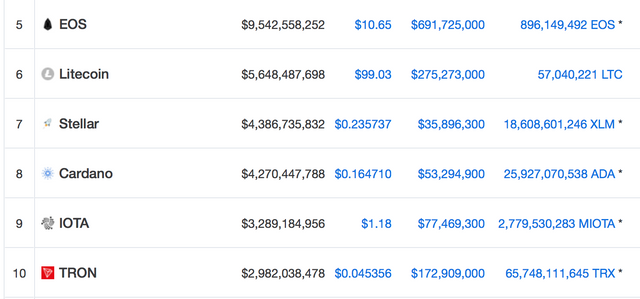RE: So many Problems and EOS at $10, No problems and TRX at $0.04 Really ? Look at the news and its unbelievable ...
It's easy to understand really... Their market caps are comparable, but when one coin has a significantly larger supply, the price is going to be low. For instance, look at the column at far right in the below picture...

That is the circulating supply shown at CoinMarketCap.com. When you have a market cap of 3 billion, but have nearly 66 billion coins, then you're at about 4 cents per coin by that division. However, EOS has a market cap of nearly 10 billion with not quite 1 billion coins which means that each coin is going to be worth about $10 USD.
The greater the supply, the worse a coin is in terms of SOV (store of value). This means that there has to be much greater market cap than EOS just to stay equal. So for TRX to have the same returns, buying in at $0.04 USD, for it to be eventually worth about $10 USD, Tron would have to have a market cap about 65 times higher than EOS. That's not very likely unless it becomes #1.
But lets say that Tron becomes the standard smart contract platform. You buy in at 0.04 and buy $1000 USD worth, that will give you 25,000 TRX tokens. Lets say you do the same with EOS and buy $1000 USD worth of EOS; that will give you somewhere in the neighborhood of about 94 EOS tokens.
Now lets say that the one that wins the dApp race will at some point be be worth 1 trillion USD. Which investment will do better? Well we take the market cap and divide it by the total supply of coins.
In Tron the total supply will be at least 66 billion. In EOS, due to inflation, this will likely be somewhere around 1.5 billion supply. TRX may also have inflation, so lets say that it's somewhere around the same rate as EOS and it turns out to have 90 billion coins. So here's the math...
TRX = 1 trillion market cap / 90 billion = 11.11 USD = 277,750 USD
EOS = 1 trillion market cap / 1.5 billion = 666.66 USD = 62666 USD
Tron did better because we bought in so low compared to the parabolic curve of its rise. However, if you were able to do the same with EOS and also buy when it was 10x that price, say at 40 cents last fall, then you would have done much better with EOS because you would have had 2500 EOS = x 666 = 1.665 million.
One trick I use is the order of magnitude difference between circulating supplies. If one coin has 10 times the supply, then it has to have 10 times the market cap to match. This should help you sort out in the parabolic curve which CAN give the greatest returns.
That I get but comparing supply TRX should still not be at 4 cents ...
Which means that it's potentially heavily undervalued.
Any good exchanges you know where to buy? This one looks pretty good.